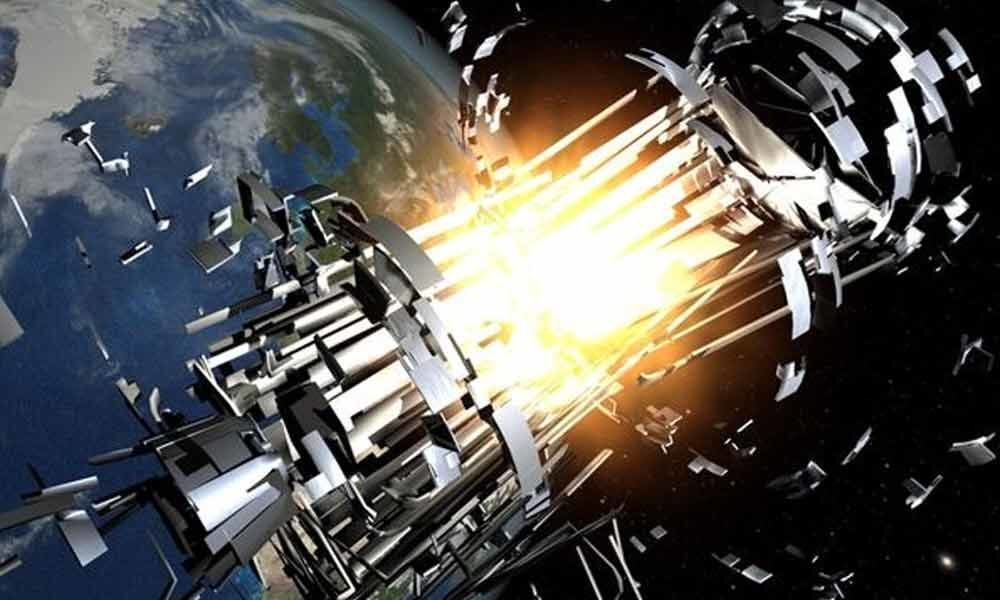The menace of orbital debris

In a test meant for boosting its fortifications in space, recently, India used a home-grown ballistic missile interceptor to destroy one of India's own satellites located at a height of 300 km.
In a test meant for boosting its fortifications in space, recently, India used a home-grown ballistic missile interceptor to destroy one of India's own satellites located at a height of 300 km.
Reacting to this event, the Pentagon on March 04, held that it stood by its assessment that debris from an Indian anti-satellite (ASAT) weapons test would eventually burn up in the atmosphere.
However, NASA's administrator presaged of the danger the debris posed, according to whom more than 400 pieces of orbital debris from the test had been identified. Such orbital debris includes those particles travelling above the International Space Station.
From the time when the first satellite was launched on October 4, 1957 (Sputnik by erstwhile USSR), the number of satellites that have been placed in the space have been burgeoned — at this time, there are more than thirteen thousand satellites and other large objects in orbit around the earth.
In order to understand the threat imposed by the orbital debris, it is imperative to understand what exactly orbital debris mean. Orbital debris is nothing but the scrap produced due to spacecraft explosions and by collisions between satellites that are moving around the earth.
Simply put—space debris is a man-made object that is not in active use. Sizes of space debris range from a large scale of uncountable smaller pieces to obsolete spacecraft and rocket bodies that stand taller than a big infrastructure on the earth.
According to an estimation, a piece of debris falls back to earth about once a day. Eventually, these microparticles either land or incinerate in the air.
Due to the major share of water on the earth, most objects that return to earth end up in water. Nonetheless, many of the objects sent into space are still in their respective orbits around the earth.
Traditionally, it has been the standard practice that a satellite after placing into its orbit, used to be left in the orbit only. However, for the reason that the debris is travelling at the same orbital speeds, it poses a significant threat to the space shuttle, space station, and other satellites placed in earth orbit.
For this reason, a heavy threat is imposed even due to a small splatter speck in space. With a collision, it can even crack a space shuttle body and create remarkable problems back on earth.
It should be understood that space debris travels at a speed 10 times faster than a bullet — as such an average bullet's speed itself is 1,700mph. Thus, the collisions caused by orbital debris result in catastrophic mission failure.
Object breakup has been a major contributor to orbital debris. Despite the fact that the reason for many of the object breakups is not known, sometimes they are caused by explosions and collisions owing to the residual propellant, overheated batteries, and due to the deliberate destruction of satellites.
In order to determine the volume of orbital debris, scientists study the space shuttle when it returns from the space orbit. Utmost care is taken in the design of the space station to make it the most heavily shielded spacecraft ever.
Beyond doubt, a space station can survive impact with smaller pieces of orbital debris and safeguard the astronauts. Specially designed spacesuits are vibrant in protecting the space crew. Materials used in bulletproof vests are used in the design of the spacesuits.
There has been a heavy increase in the volume of space debris due to the launch of many satellites. Thus, the threat caused due to the space debris is multiplied in leaps and bounds.
Consequently, there arises a dire need to address this problem. Many international space agencies have been striving hard to reduce the problem caused due to orbital debris.
For example, the upper stages of launch vehicles, and some satellites are being placed in lower orbits. This is to ensure that the orbital debris re-enters the atmosphere and burn up more readily.
In order to prevent old satellites, other space objects, and the orbital debris that they engender from making low-earth-orbit (LEO) unusable, a provision must be made for removing the used satellites and spent rockets from orbit.
There are various methods for removing the used satellites. One method of removing a satellite from orbit is carrying extra propellant so that the satellite can bring itself down out of the orbit. However, this method has its own limitations as it burdens carrying of heavy propellant — thus making the rocket carrying a satellite, bulkier.
Recent studies have shown that satellites left in a higher orbit will slowly break apart as micrometeorites and will eventually endanger operational satellites.
Moreover, once the old satellites split into smaller particles, it will be nearly impossible to clean up the debris. Consequently, it will be much more cost effective in the long run to deal with the problem.
Currently, there is no law requiring that old satellites be removed from orbit. However, NASA has recently effected a guideline for its own satellites. In the same lines, it is imperative for all other space organisations run by various nations to formulate their own guidelines.
Major space organisations like ISRO and NASA should join hands to congregate the nations to formulate an international law to address the problem of orbital debris.
(The author is an Air Veteran, a mass communicator and an author of more than 10 mass media books)















